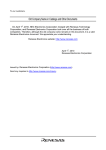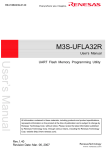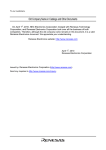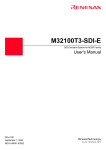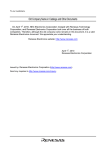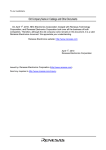Download Renesas SDI Emulator System M32100T-EZ-E Technical information
Transcript
To our customers, Old Company Name in Catalogs and Other Documents On April 1st, 2010, NEC Electronics Corporation merged with Renesas Technology Corporation, and Renesas Electronics Corporation took over all the business of both companies. Therefore, although the old company name remains in this document, it is a valid Renesas Electronics document. We appreciate your understanding. Renesas Electronics website: http://www.renesas.com April 1st, 2010 Renesas Electronics Corporation Issued by: Renesas Electronics Corporation (http://www.renesas.com) Send any inquiries to http://www.renesas.com/inquiry. Notice 1. 2. 3. 4. 5. 6. 7. All information included in this document is current as of the date this document is issued. Such information, however, is subject to change without any prior notice. Before purchasing or using any Renesas Electronics products listed herein, please confirm the latest product information with a Renesas Electronics sales office. Also, please pay regular and careful attention to additional and different information to be disclosed by Renesas Electronics such as that disclosed through our website. Renesas Electronics does not assume any liability for infringement of patents, copyrights, or other intellectual property rights of third parties by or arising from the use of Renesas Electronics products or technical information described in this document. No license, express, implied or otherwise, is granted hereby under any patents, copyrights or other intellectual property rights of Renesas Electronics or others. You should not alter, modify, copy, or otherwise misappropriate any Renesas Electronics product, whether in whole or in part. Descriptions of circuits, software and other related information in this document are provided only to illustrate the operation of semiconductor products and application examples. You are fully responsible for the incorporation of these circuits, software, and information in the design of your equipment. Renesas Electronics assumes no responsibility for any losses incurred by you or third parties arising from the use of these circuits, software, or information. When exporting the products or technology described in this document, you should comply with the applicable export control laws and regulations and follow the procedures required by such laws and regulations. You should not use Renesas Electronics products or the technology described in this document for any purpose relating to military applications or use by the military, including but not limited to the development of weapons of mass destruction. Renesas Electronics products and technology may not be used for or incorporated into any products or systems whose manufacture, use, or sale is prohibited under any applicable domestic or foreign laws or regulations. Renesas Electronics has used reasonable care in preparing the information included in this document, but Renesas Electronics does not warrant that such information is error free. Renesas Electronics assumes no liability whatsoever for any damages incurred by you resulting from errors in or omissions from the information included herein. Renesas Electronics products are classified according to the following three quality grades: “Standard”, “High Quality”, and “Specific”. The recommended applications for each Renesas Electronics product depends on the product’s quality grade, as indicated below. You must check the quality grade of each Renesas Electronics product before using it in a particular application. You may not use any Renesas Electronics product for any application categorized as “Specific” without the prior written consent of Renesas Electronics. Further, you may not use any Renesas Electronics product for any application for which it is not intended without the prior written consent of Renesas Electronics. Renesas Electronics shall not be in any way liable for any damages or losses incurred by you or third parties arising from the use of any Renesas Electronics product for an application categorized as “Specific” or for which the product is not intended where you have failed to obtain the prior written consent of Renesas Electronics. The quality grade of each Renesas Electronics product is “Standard” unless otherwise expressly specified in a Renesas Electronics data sheets or data books, etc. “Standard”: 8. 9. 10. 11. 12. Computers; office equipment; communications equipment; test and measurement equipment; audio and visual equipment; home electronic appliances; machine tools; personal electronic equipment; and industrial robots. “High Quality”: Transportation equipment (automobiles, trains, ships, etc.); traffic control systems; anti-disaster systems; anticrime systems; safety equipment; and medical equipment not specifically designed for life support. “Specific”: Aircraft; aerospace equipment; submersible repeaters; nuclear reactor control systems; medical equipment or systems for life support (e.g. artificial life support devices or systems), surgical implantations, or healthcare intervention (e.g. excision, etc.), and any other applications or purposes that pose a direct threat to human life. You should use the Renesas Electronics products described in this document within the range specified by Renesas Electronics, especially with respect to the maximum rating, operating supply voltage range, movement power voltage range, heat radiation characteristics, installation and other product characteristics. Renesas Electronics shall have no liability for malfunctions or damages arising out of the use of Renesas Electronics products beyond such specified ranges. Although Renesas Electronics endeavors to improve the quality and reliability of its products, semiconductor products have specific characteristics such as the occurrence of failure at a certain rate and malfunctions under certain use conditions. Further, Renesas Electronics products are not subject to radiation resistance design. Please be sure to implement safety measures to guard them against the possibility of physical injury, and injury or damage caused by fire in the event of the failure of a Renesas Electronics product, such as safety design for hardware and software including but not limited to redundancy, fire control and malfunction prevention, appropriate treatment for aging degradation or any other appropriate measures. Because the evaluation of microcomputer software alone is very difficult, please evaluate the safety of the final products or system manufactured by you. Please contact a Renesas Electronics sales office for details as to environmental matters such as the environmental compatibility of each Renesas Electronics product. Please use Renesas Electronics products in compliance with all applicable laws and regulations that regulate the inclusion or use of controlled substances, including without limitation, the EU RoHS Directive. Renesas Electronics assumes no liability for damages or losses occurring as a result of your noncompliance with applicable laws and regulations. This document may not be reproduced or duplicated, in any form, in whole or in part, without prior written consent of Renesas Electronics. Please contact a Renesas Electronics sales office if you have any questions regarding the information contained in this document or Renesas Electronics products, or if you have any other inquiries. (Note 1) “Renesas Electronics” as used in this document means Renesas Electronics Corporation and also includes its majorityowned subsidiaries. (Note 2) “Renesas Electronics product(s)” means any product developed or manufactured by or for Renesas Electronics. Rev.3.00 Aug.01.09 REJ10J0013-0300 Be Sure to Read This First. SDI Emulator System for the M32R Family MCUs M32100T-EZ-E Release Notes Renesas Solutions Corp. Aug. 1, 2009 Outline These release notes explain the specifications, cautions and restrictions dependent on MCU models which are not covered by the M32100T-EZ-E User's Manual. When referring to a required section in the user's manual, read the release notes together with the user's manual. Contents Page 1. MCU Model List ....................................................................................................................................................3 2. Specifications, Cautions and Restrictions Dependent on the MCU Model...........................................................3 2.1. 32102 Group...............................................................................................................................................4 2.2. 32104 Group...............................................................................................................................................6 2.3. 32121 Group...............................................................................................................................................8 2.4. 3217x Group .............................................................................................................................................10 2.5. 3218x and 3219x Groups .........................................................................................................................11 1 Regulatory Compliance Notices European Union regulatory notices on Electromagnetic compatibility CE Certifications: This product complies with the following European EMC standards. ・EMC Directive 2004/108/EC EN 55022 Class A WARNING: This is a Class A product. In a domestic environment this product may cause radio interference in which case the user may be required to take adequate measures. EN 55024 Information for traceability: ・Authorised representative Name: Renesas Technology Corp. Address: Nippon Bldg., 2-6-2, Ote-machi, Chiyoda-ku, Tokyo 100-0004, Japan ・Manufacturer Name: Renesas Solutions Corp. Address: Nippon Bldg., 2-6-2, Ote-machi, Chiyoda-ku, Tokyo 100-0004, Japan ・Person responsible for placing on the market Name: Renesas Technology Europe Limited European Headquaters Address: Dukes Meadow, Millboard Road, Bourne End, Buckinghamshire, SL8 5FH, U.K. United States Regulatory notices on Electromagnetic compatibility FCC Certifications: This equipment has been tested and found to comply with the limits for a Class A digital device, pursuant to Part 15 of the FCC Rules. These limits are designed to provide reasonable protection against harmful interference when the equipment is operated in a commercial environment. This equipment generates, uses, and can radiate radio frequency energy and, if not installed and used in accordance with the instruction manual, may cause harmful interference to radio communications. Operation of this equipment in a residential area is likely to cause harmful interference in which case the user will be required to correct the interference at his own expense. This device complies with Part 15 of the FCC Rules. Operation is subject to the following two conditions: (1) this device may not cause harmful interference, and (2) this device must accept any interference received, including interference that may cause undesired operation. CAUTION: Changes or modifications not expressly approved by the party responsible for compliance could void the user's authority to operate the equipment. 2 1. MCU Model List These release notes cover the MCU models listed in Table 1. Table 1 MCU model list Group 32102 Group 32104 Group 32121 Group 32170 Group 32171 Group 32172 Group 32173 Group 32174 Group 32176 Group 32180 Group 32182 Group 32185 Group 32186 Group 32192 Group 32195 Group 32196 Group Part No. M32102S6FP M32104S6FP M32121xCWG M32170FxxFP M32171FxxFP M32172FxxFP, M32172FxxWG M32173FxxFP, M32173FxxWG M32174FxVFP M32176FxxFP, M32176FxxWP M32180FxxFP M32182FxxFP M32185FxxFP M32186FxxFP M32192FxxFP M32195FxxFP M32196FxxFP 2. Specifications, Cautions and Restrictions Dependent on the MCU Model The following explains the emulator specifications, cautions and restrictions dependent on the MCU model. 3 2.1. 32102 Group (1) Differences between the emulator and MCUs IMPORTANT z The emulator initializes the MCU internal register to the following values. Initialization starts when the power switch is turned ON or MCU is reset. R0 = 00000000 R5 = 00000000 R10 = 00000000 R15 = 00000100 ACCH = xxxxxxxx PSW = 00000000 R1 = 00000000 R6 = 00000000 R11 = 00000000 SPI = 00000100 ACCL = xxxxxxxx R2 = 00000000 R7 = 00000000 R12 = 00000000 SPU = 00000100 R3 = 00000000 R8 = 00000000 R13 = 00000000 BPC = 00000000 R4 = 00000000 R9 = 00000000 R14 = 00000000 PC = 00000000 (2) MCU signals connected to the SDI MCU control interface connector (Section 3.2) Pin No. 1 2 3 4 5 6 7 8 9 10 Pin Direction Connected to TCLK Vss TDI TDO TMS TRST DBI N.C. Vcc RST Emulator to target Emulator to target Target to emulator Emulator to target Emulator to target Emulator to target Target to emulator Emulator to target TCK of MCU GND (0 V) TDI of MCU TDO of MCU TMS of MCU TRST# of MCU DBI# of MCU Not used VCCX of MCU System reset Remarks Clock frequency: 5 MHz Totem pole output on the emulator Open corrector output on the emulator (3) Debug specifications dependent on MCU model (Section 5.1) Item Emulation memory Software break Hardware break RAM area ROM area Forcible break Data access break Description - No built-in emulation memory provided in the emulator - Function to download the data to an external flash ROM supported Implemented by instruction replacement Implemented by preexecution PC breakpoints of MCU (4 points) Implemented by MCU’s internal resources Implemented by MCU’s internal resources (2 data access break points) 4 (4) Other cautions and restrictions dependent on MCU model IMPORTANT z Note on Using the MVTC Instruction (1): When the user program is stopped by the MVTC instruction at the address of the instruction which operates BPC, a BPC value may be changed even if the MVTC instruction has not been executed. Occurrence of this phenomenon depends on the MCU status and the instruction sequence. After this phenomenon occurs, the program is normally re-executed starting with the PC value of the MVTC instruction. The following shows sample data when the phenomenon occurs. Example: Address Instruction H'100 LD24 R0, #H'100 H'104 MVTC R0, BPC H'106 NOP . . . . When a break occurs at PC = H'104 in the above program fragment, BPC = H'100 may be enabled even before the MVTC instruction is executed. z Note on Using the MVTC Instruction (2): In cases when instructions used to operate on the BPC with the MVTC instruction are followed by an RTE instruction, do not set a preexecution PC breakpoint for the RTE instruction. This is because the BPC value becomes illegal and the program cannot be run normally after a break. The following shows sample data when the phenomenon occurs. Example: Address Instruction H'100 LD24 R0, #H'100 H'104 MVTC R0, BPC H'106 NOP . . . . H'110 RTE If in the above program fragment a preexecution PC breakpoint is set at PC = H'110 to cause a break, the BPC value becomes illegal. z Note on WDT: If a user program is stopped during operation of WDT built in the MCU, the WDT count halts meanwhile. This prevents SBI interruption by WDT while the user program is stopped. However, WDT is normally initialized then. 5 2.2. 32104 Group (1) Differences between the emulator and MCUs IMPORTANT z The emulator initializes the MCU internal register to the following values. Initialization starts when the power switch is turned ON or MCU is reset. R0 = 00000000 R5 = 00000000 R10 = 00000000 R15 = 00000100 ACCH = xxxxxxxx PSW = 00000000 R1 = 00000000 R6 = 00000000 R11 = 00000000 SPI = 00000100 ACCL = xxxxxxxx R2 = 00000000 R7 = 00000000 R12 = 00000000 SPU = 00000100 R3 = 00000000 R8 = 00000000 R13 = 00000000 BPC = 00000000 R4 = 00000000 R9 = 00000000 R14 = 00000000 PC = 00000000 (2) MCU signals connected to the SDI MCU control interface connector (Section 3.2) Pin No. 1 2 3 4 5 6 7 8 9 10 Pin Direction Connected to TCLK Vss TDI TDO TMS TRST DBI N.C. Vcc RST Emulator to target Emulator to target Target to emulator Emulator to target Emulator to target Emulator to target Target to emulator Emulator to target TCK of MCU GND (0 V) TDI of MCU TDO of MCU TMS of MCU TRST# of MCU DBI# of MCU Not used VCCX of MCU System reset Remarks Clock frequency: 5 MHz Totem pole output on the emulator Not used when using M32104S6FP Open corrector output on the emulator (3) Debug specifications dependent on MCU model (Section 5.1) Item Emulation memory Software break Hardware break RAM area ROM area Forcible break Data access break Description - No built-in emulation memory provided in the emulator - Function to download the data to an external flash ROM supported Implemented by instruction replacement Implemented by preexecution PC breakpoints of MCU (4 points) Implemented by MCU’s internal resources Implemented by MCU’s internal resources (2 data access break points) 6 (4) Other cautions and restrictions dependent on MCU model IMPORTANT z Note on Using the MVTC Instruction (1): When the user program is stopped by the MVTC instruction at the address of the instruction which operates BPC, a BPC value may be changed even if the MVTC instruction has not been executed. Occurrence of this phenomenon depends on the MCU status and the instruction sequence. After this phenomenon occurs, the program is normally re-executed starting with the PC value of the MVTC instruction. The following shows sample data when the phenomenon occurs. Example: Address Instruction H'100 LD24 R0, #H'100 H'104 MVTC R0, BPC H'106 NOP . . . . When a break occurs at PC = H’104 in the above program fragment, BPC = H’100 may be enabled even before the MVTC instruction is executed. z Note on Using the MVTC Instruction (2): In cases when instructions used to operate on the BPC with the MVTC instruction are followed by an RTE instruction, do not set a preexecution PC breakpoint for the RTE instruction. This is because the BPC value becomes illegal and the program cannot be run normally after a break. The following shows sample data when the phenomenon occurs. Example: Address Instruction H'100 LD24 R0, #H'100 H'104 MVTC R0, BPC H'106 NOP . . . . H'110 RTE If in the above program fragment a preexecution PC breakpoint is set at PC = H'110 to cause a break, the BPC value becomes illegal. 7 2.3. 32121 Group (1) Differences between the emulator and MCUs IMPORTANT z The emulator initializes the MCU internal register to the following values. Initialization starts when the power switch is turned ON or MCU is reset. R0 = 00000000 R5 = 00000000 R10 = 00000000 R15 = 00000100 ACCH = xxxxxxxx PSW = 00000000 R1 = 00000000 R6 = 00000000 R11 = 00000000 SPI = 00000100 ACCL = xxxxxxxx R2 = 00000000 R7 = 00000000 R12 = 00000000 SPU = 00000100 R3 = 00000000 R8 = 00000000 R13 = 00000000 BPC = 00000000 R4 = 00000000 R9 = 00000000 R14 = 00000000 PC = 00000000 z To execute a target program which transfers to the sleep mode or to the stop mode, you must observe the following restrictions because of the MCU specifications: (1) Add the instructions given below after the store instruction which transfers the target program to the sleep/stop mode. (2) Do not set a break point between the STB instruction and the last NOP instruction added. Target program . . Store instruction BRA NOP NOP . . NOP LOOP: <--Instruction to transfer to the sleep/stop mode LOOP Insert 16 NOP instructions after the address branch command. z When a break is forced while the target MCU is set in the sleep/stop mode, the target MCU may return to the normal mode. Also when memory is referenced or set while the target MCU is set in the sleep/stop mode, the target MCU may return to the normal mode from the sleep/stop mode. z Do not change the target MCU to the sleep/stop mode using the memory rewrite function of the emulator debugger. (2) MCU signals connected to the SDI MCU control interface connector (Section 3.2) Pin No. 1 2 3 4 5 6 7 8 Pin Direction Connected to TCLK Vss TDI TDO TMS TRST DBI FVCC Emulator to target Emulator to target Target to emulator Emulator to target Emulator to target Emulator to target Emulator to target TCK of MCU GND (0 V) TDI of MCU TDO of MCU TMS of MCU TRST# of MCU DBI# of MCU FVCC of MCU 9 10 Vcc RST Target to emulator Emulator to target VCCX of MCU System reset 8 Remarks Clock frequency: 5 MHz Totem pole output on the emulator Voltage is set to 2.5 V. Turned ON/OFF according to the setting of the FVCC switch. Open corrector output on the emulator (3) Debug specifications dependent on MCU model (Section 5.1) Item Emulation memory Software break Hardware break RAM area ROM area Forcible break Data access break Description Flash ROM built in MCU used as emulation memory Implemented by instruction replacement Implemented by preexecution PC breakpoints of MCU (4 points) Implemented by MCU’s internal resources Implemented by MCU’s internal resources (2 data access break points) (4) Other cautions and restrictions dependent on MCU model IMPORTANT z Note on Using the MVTC Instruction (1): When the user program is stopped by the MVTC instruction at the address of the instruction which operates BPC, a BPC value may be changed even if the MVTC instruction has not been executed. Occurrence of this phenomenon depends on the MCU status and the instruction sequence. After this phenomenon occurs, the program is normally re-executed starting with the PC value of the MVTC instruction. The following shows sample data when the phenomenon occurs. Example: Address Instruction H'100 LD24 R0, #H'100 H'104 MVTC R0, BPC H'106 NOP . . . . When a break occurs at PC = H’104 in the above program fragment, BPC = H’100 may be enabled even before the MVTC instruction is executed. z Note on Using the MVTC Instruction (2): In cases when instructions used to operate on the BPC with the MVTC instruction are followed by an RTE instruction, do not set a preexecution PC breakpoint for the RTE instruction. This is because the BPC value becomes illegal and the program cannot be run normally after a break. The following shows sample data when the phenomenon occurs. Example: Address Instruction H'100 LD24 R0, #H'100 H'104 MVTC R0, BPC H'106 NOP . . . . H'110 RTE If in the above program fragment a preexecution PC breakpoint is set at PC = H'110 to cause a break, the BPC value becomes illegal. z Note on WDT: If a user program is stopped during operation of WDT built in the MCU, the WDT count halts meanwhile. This prevents SBI interruption by WDT while the user program is stopped. However, WDT is normally initialized then. 9 2.4. 3217x Group (1) Differences between the emulator and MCUs IMPORTANT z The emulator initializes the MCU internal register to the following values. Initialization starts when the power switch is turned ON or MCU is reset. R0 = 00000000 R5 = 00000000 R10 = 00000000 R15 = 00000100 ACCH = xxxxxxxx PSW = 00000000 R1 = 00000000 R6 = 00000000 R11 = 00000000 SPI = 00000100 ACCL = xxxxxxxx R2 = 00000000 R7 = 00000000 R12 = 00000000 SPU = 00000100 R3 = 00000000 R8 = 00000000 R13 = 00000000 BPC = 00000000 R4 = 00000000 R9 = 00000000 R14 = 00000000 PC = 00000000 (2) MCU signals connected to the SDI MCU control interface connector (Section 3.2) Pin No. 1 2 3 4 5 6 7 8 9 10 Pin Direction Connected to TCLK Vss TDI TDO TMS TRST DBI N.C. Vcc RST Emulator to target Emulator to target Target to emulator Emulator to target Emulator to target Emulator to target Target to emulator Emulator to target JTCK of MCU GND (0 V) JTDI of MCU JTDO of MCU JTMS of MCU JTRST of MCU JDBI of MCU Not used VCCE of MCU System reset Remarks Clock frequency: 5 MHz Totem pole output on the emulator Not used when using M3217xFxxFP Open corrector output on the emulator (3) Debug specifications dependent on MCU model (Section 5.1) Item Emulation memory Software break Hardware break RAM area ROM area Forcible break Data access break Description Flash ROM built in MCU used as emulation memory Implemented by instruction replacement Implemented by preexecution PC breakpoints of MCU (4 points) Implemented by MCU’s internal resources Implemented by MCU’s internal resources (2 data access break points) 10 2.5. 3218x and 3219x Groups (1) Differences between the emulator and MCUs IMPORTANT z The emulator initializes the MCU internal register to the following values. Initialization starts when the power switch is turned ON or MCU is reset. R0 = 00000000 R5 = 00000000 R10 = 00000000 R15 = 00000100 ACCH = xxxxxxxx PSW = 00000000 R1 = 00000000 R6 = 00000000 R11 = 00000000 SPI = 00000100 ACCL = xxxxxxxx R2 = 00000000 R7 = 00000000 R12 = 00000000 SPU = 00000100 R3 = 00000000 R8 = 00000000 R13 = 00000000 BPC = 00000000 R4 = 00000000 R9 = 00000000 R14 = 00000000 PC = 00000000 (2) MCU signals connected to the SDI MCU control interface connector (Section 3.2) Pin No. 1 2 3 4 5 6 7 Pin Direction Connected to TCLK Vss TDI TDO TMS TRST DBI Emulator to target Emulator to target Target to emulator Emulator to target Emulator to target Emulator to target JTCK of MCU GND (0 V) JTDI of MCU JTDO of MCU JTMS of MCU JTRST of MCU JDBI of MCU 8 FVCC Emulator to target SDIVCC of MCU 9 10 Vcc RST Target to emulator Emulator to target VCCE of MCU System reset Remarks Clock frequency: 5 MHz Totem pole output on the emulator Not used when using M3218xFxxFP and M3219xFxxFP Not used when using M3218xFxxFP and M3219xFxxFP Open corrector output on the emulator (3) Debug specifications dependent on MCU model (Section 5.1) Item Emulation memory Software break Hardware break RAM area ROM area Forcible break Data access break Description Flash ROM built in MCU used as emulation memory Implemented by instruction replacement Implemented by preexecution PC breakpoints of MCU (4 points) Implemented by MCU’s internal resources Implemented by MCU’s internal resources (2 data access break points) 11













